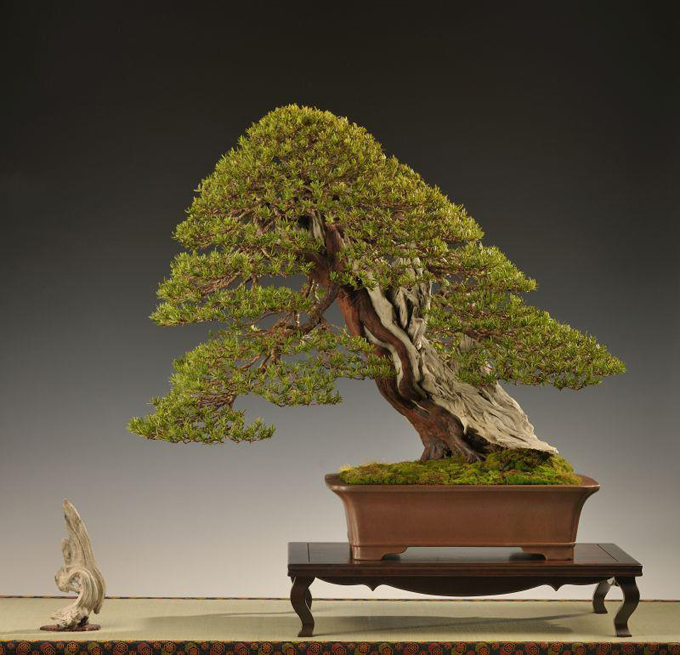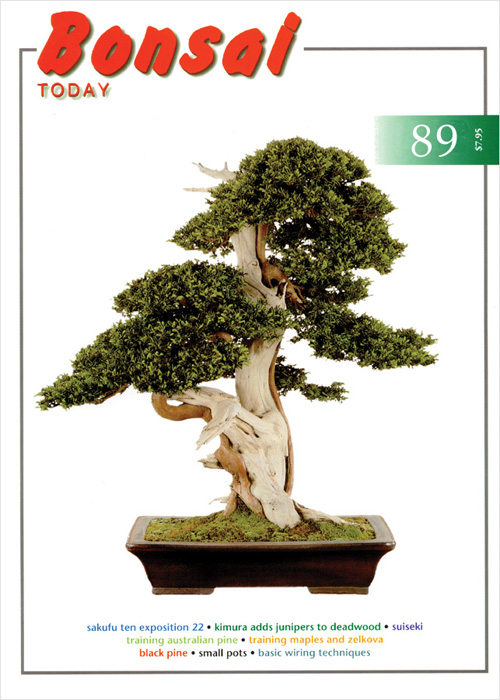 The powerful tree with its heavy flowing deadwood (it reminds me of melting wax) and luscious reddish bark is truly wonderful, but then there’s that little companion too. Have you ever seen a piece of deadwood used as a bonsai companion? This Taxus (yew) and charming little piece of deadwood belong to Mauro Stemberger. The pot is a Tokoname.
The powerful tree with its heavy flowing deadwood (it reminds me of melting wax) and luscious reddish bark is truly wonderful, but then there’s that little companion too. Have you ever seen a piece of deadwood used as a bonsai companion? This Taxus (yew) and charming little piece of deadwood belong to Mauro Stemberger. The pot is a Tokoname.
Species specific series. I’ve been thinking about starting a species specific series (in this case it’s actually genus specific). We’ve devoted posts to certain species before, but haphazardly and without any notion of doing a series. So we’ll consider this the first in our new series of species (or genus) specific posts.
In praise of the under appreciated yew. Bad puns aside, I know that I’ve praised yew before, still, at the risk of repeating myself, I’m a big fan. For landscaping and for bonsai.
Landscaping. Yews are often over-used in landscaping and as a result their beauty is not always appreciated. Another problem is that the wood is usually often by the foliage. This is a shame as the color and gnarly shapes that the wood takes on can be stunning, especially with age. And then there’s that brilliant yellow green new growth in the spring.
Bonsai. Back in the day (it was a Wednesday) when I started bonsai, you didn’t see that many yews being used for bonsai and to some extent, you really don’t see that many still. Perhaps this is because they are so common and the beauty of the wood is often hidden in landscapes (especially on the low growing dense varieties, which make the best bonsai). The extreme hardness of the wood probably doesn’t help either. Conversely, they are very tough, and respond to pruning and root pruning with flying colors. Carving too, if you have the patience and strength (or power tools) to work their extremely hard wood. Once they are carved, the deadwood can be quite beautiful (especially in contrast to their striking reddish brown bark). As an extra plus, yews are more rot resistant than most trees. And then there’s that beautiful spring foliage.
 Every time I open Bonsai Today issue 106 and lay my eyes on this wickedly powerful old English yew, my mind does a little double take. It may not look exactly like anything you’ll see in nature, but it certainly jumps off the page. It’s by Kevin Willson. Photo by Simon Carr.
Every time I open Bonsai Today issue 106 and lay my eyes on this wickedly powerful old English yew, my mind does a little double take. It may not look exactly like anything you’ll see in nature, but it certainly jumps off the page. It’s by Kevin Willson. Photo by Simon Carr.
 The foliage on this one is not quite show-ready, but the rest of the tree, wild deadwood and all, certainly is. It’s by Mario Komsta (he’s been showing up here on Bonsai Bark a lot lately).
The foliage on this one is not quite show-ready, but the rest of the tree, wild deadwood and all, certainly is. It’s by Mario Komsta (he’s been showing up here on Bonsai Bark a lot lately).
 This dynamic Japanese yew (Taxus cuspidata) with is fluid play of strikingly attractive dead and live wood, and its perfectly balanced foliage, is from cover of Bonsai Today issue 89 (below). Unfortunately, the artist’s name was lost somewhere in translation.
This dynamic Japanese yew (Taxus cuspidata) with is fluid play of strikingly attractive dead and live wood, and its perfectly balanced foliage, is from cover of Bonsai Today issue 89 (below). Unfortunately, the artist’s name was lost somewhere in translation.
 All back issues of Bonsai Today are currently 75% off at Stone Lantern.
All back issues of Bonsai Today are currently 75% off at Stone Lantern.
I, and others in our bonsai club, also enjoy working with yews. In the northeast, old yews are frequently available from landscapes as people give up trying to protect them from the ravages of deer. Yew, azaleas, hosta and daylilies are all considered deer candy in these parts, and no longer planted in the open.
Hi Fred,
Yeah, deer candy. I cover mine with burlap along with all my cedars, hemlocks, some junipers and surprisingly, some non-native spruce (Picea abies varieties), all of which I learned about the hard way.
Thanks for posting this. Stemberger’s yew at the top is splendid, and his use of that deadwood companion was a stroke of inspiration!